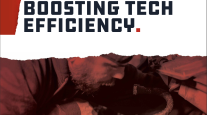Division Head, Commercial Solutions
Design Interactive Inc.
Perspective: Augmented Reality as a Training Tool
[Stay on top of transportation news: Get TTNews in your inbox.]
Imagine a doctor using a headset to visualize a patient’s broken bone and plan out a treatment. Or a worker conducting a quality assurance review before delivery of equipment; the headset guides the individual step-by-step through the parts or components to inspect, with visual examples. Or picture an assembly worker using a headset that guides them through which tasks to perform and in what order. All of this is possible through an emerging technology called augmented reality.
For the trucking industry, there is one area where it shows particular promise: technician training.
What is Augmented Reality?

Johnston
Augmented reality superimposes content — including video, audio, text and 3D holograms — onto the real world through headsets or mobile devices.
In everyday life, you might have seen examples of augmented reality. Players of Pokemon Go, a popular mobile video game, look at their phones to “see” and capture Pokemon characters inserted into real life, such as on a desk or a bookshelf. Or you may have seen ads for Amazon.com and Ikea mobile apps that allow you to visually insert furniture into your home on your phone screen to see how it would fit.
For technician training, augmented reality can use cameras with computer vision algorithms to place training content such as videos or animated holograms of equipment in the environment where service and repair tasks are performed. For example, if a vehicle requires an inspection of its brakes, the steps in the procedure are placed near or on the parts of the brake. Users can see 3D virtual representations of parts for reference during inspection or repairs, as well as videos, audio messages and text instruction.
Recruitment and Retention
The trucking industry continues to face a multipronged uphill battle when it comes to technicians — companies not only need to attract qualified technicians, they need to retain them once they’ve been hired.
This urgency is compounded by workforce projections: According to the U.S. Department of Labor’s Bureau of Labor Statistics, diesel service technician employment is projected to grow 5% from 2018 to 2028, creating the need for nearly 14,000 new technicians within the next nine years.
One hurdle is that the field suffers from an outdated image — one that involves manual processes despite the advent of electronics on vehicles and high-tech diagnostic tools in shops. As other industries adopt augmented reality and similar technology, competition for the best and brightest technical minds who want to work with cutting-edge technology will get even tighter. The industry needs to embrace technology to attract those workers.
Plus, new and current technicians alike require advanced training for today’s highly sophisticated vehicles.
Less experienced technicians could use augmented reality as an introduction to components or repair procedures. Such usage also could ease the workload of more experienced technicians who sometimes mentor younger entrants to the field. While mentoring responsibilities would likely still be important, the workload could be lightened if younger technicians are able to practice more procedures on their own.
Meanwhile, experienced technicians might use augmented reality as a refresher, particularly if they haven’t performed a procedure in some time.
Potential Savings
One benefit of augmented reality is its flexibility. Typically, technician training is conducted in a centralized location, and often hosted by a partner such as a vendor or original equipment manufacturer at a significant cost. For example, if you plan to train technicians across your fleet in tire analysis you may incur the costs of shipping training aids, renting a facility and travel. With augmented reality, however, a subject matter expert could livestream a training session through a website to all technicians simultaneously, and walk through an analysis with all necessary training aids. Afterward, any technician that did not attend could watch a recorded video of the training session, and every technician could download the augmented reality procedure the trainer used on their mobile devices or headsets for later use.
Augmented reality may sound futuristic, but it’s here already, from mobile games to high-level technical training. As the trucking industry contends with a technician shortage, augmented reality may help answer questions ranging from recruitment to increased efficiency.
For new entrants to the industry, the faster that content is mastered by young technicians, the quicker they accelerate to become more competent and can be trusted with a variety of procedures — including more complex repairs — to help keep the wheels of trucking turning.
Matt Johnston is the division head of Commercial Solutions at Design Interactive Inc., a developer of augmented, virtual and mixed reality training solutions.
Want more news? Listen to today's daily briefing:


